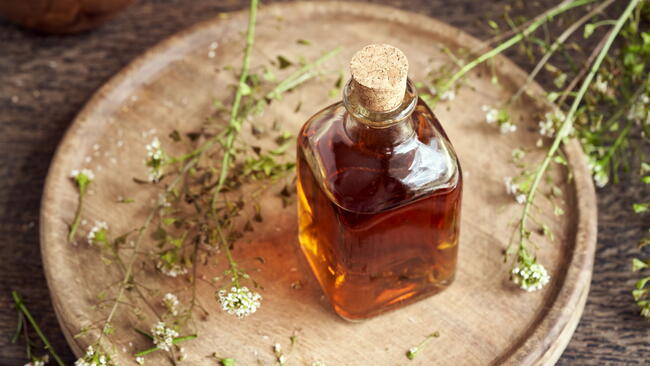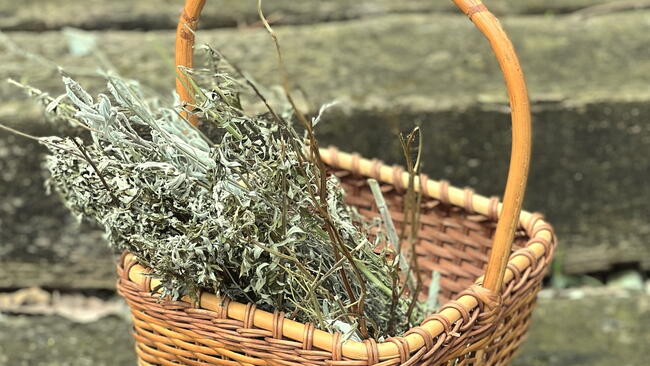Got dry skin? Turn herbs into a healing salve. Herbal salves have been used for centuries as the premier household first aid for chapped skin, scrapes, and more. While the word “salve” may sound fancy, it refers to a two-ingredient ointment that takes 30 minutes to make, start to finish. Learn how!
A salve is simply an oil (olive oil, almond oil) infused with herbs and combined with wax (beeswax) to thicken them into a solid state at room temperature. That’s it! Although salves are often expensive to buy, they’re quick and simple to make at home. Almost any herb will work.
Salves are great for gardeners with small scrapes from branches, occasional nettle rash, and insect bites. (It’s very satisfying to use herbs from the garden to cure scrapes from the garden!)
Which Flowers or Plants to Use
You can make an herbal salve out of one of the dozens of wild and cultivated plants that flourish where you live. Of course, it’s best when herbs are in full leaf and flowering, concentrating their active healing constituents in their aboveground parts. However, you can also find all these ingredients (dried herbs, oil, beeswax pastilles) in stores or even on Amazon for an indoor project.
I commonly use comfrey, burdock, lemon balm, yarrow, self-heal, and plantain. Later in the season, I will make flower salves from mullein, calendula, and St. John’s wort. It’s fun to experiment and learn about the herbs and their uses as you go.
In this recipe, I am making a general-purpose household salve of comfrey and plantain leaves. Both herbs have been used for thousands of years for natural healing; plus, the plantain grows abundantly in my lawn!
Comfrey means “knitting together” in Latin, as it actually speeds up new skin and cell growth. It helps new skin form so fast that herbalists don’t recommend using it for deep wounds that require slow healing. Plantain enjoys equal renown as an anti-itch, anti-inflammatory herb.
Making the Herbal Salve
- Start by picking the flowers and leaves fresh from the garden. Take these slightly wilting plants, chop them up, and pack them loosely into a clean glass jar. I chop up about 1 cup of leaves. (In this case, I chopped up 1/2 cup of comfrey and 1/2 cup of dry plantain leaves.)
- Cover with about 1-1/2 cup oil. You can use olive oil, or sunflower oil, or sesame oil. Or, I often use a combination of grapeseed and coconut oil. Our ancestors didn’t have access to pressed oils; they made their healing ointments from bear grease, lard, and other animal fats, which reportedly have healing powers of their own.
- I cover the top of the jar with cheesecloth or a coffee filter secured with a rubber band. This allows moisture that would otherwise spoil the salve to escape from the jar.
- Then, I leave the jar on a sunny windowsill for 2 or 3 weeks, shaking or stirring the infusion whenever I think of it, usually once or twice a day, using a long wooden spoon.
- When the herbs have infused long enough, I strain the plant material out with a cheesecloth, catching the oil in a glass pitcher and twisting the end of the cloth to squeeze as much oil as possible from the leafy material.
- The final step is to melt pure beeswax (use a double boiler on the stove or a Pyrex cup within a glass bowl in the microwave) and add it to the infused oil in a ratio of about five parts oil to one part melted wax. Stir with a wooden spoon and store in a sterilized glass or metal container.
It’s easy to adjust the consistency of a salve by adding a bit more oil to make it more spreadable or more beeswax to thicken or harden it. Homemade salves without any preservative agents will last about 6 to 8 months at room temperature out of direct heat and sunlight. Refrigerated, they’ll keep for a year or more.
My comfrey-plantain salve is versatile. I’ll use it on itches and stings, chapped hands and lips, cracked heels, ragged cuticles, nicks, cuts, and scrapes. It also works wonders on diaper and heat rash.
One caution: Clean and disinfect a fresh wound, then wait for it to stop bleeding before applying any salve. You don’t want to seal in an infectious agent.
Now, see how to make an herbal tincture.










Comments